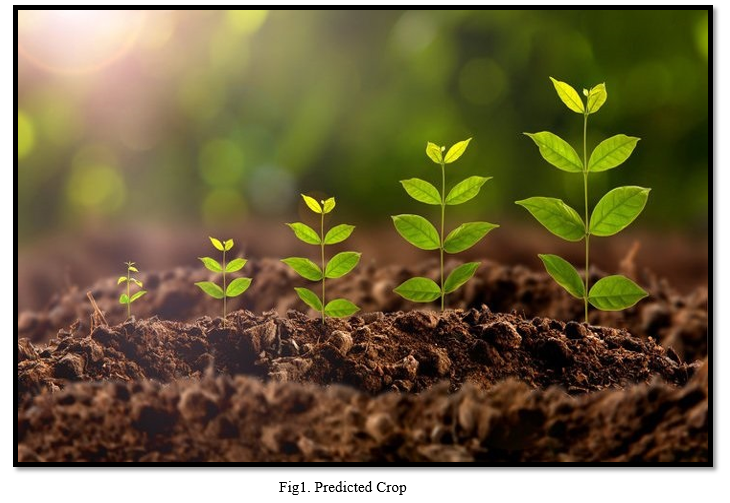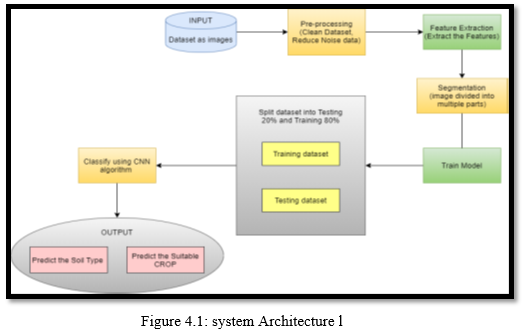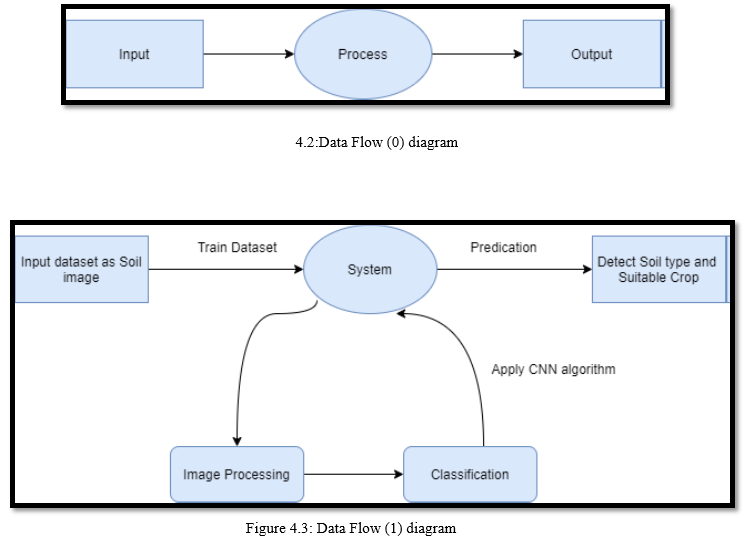Ijraset Journal For Research in Applied Science and Engineering Technology
- Home / Ijraset
- On This Page
- Abstract
- Introduction
- Conclusion
- References
- Copyright
Crop Prediction Using CNN Algorithm
Authors: Aditya Dhanraj Ramekar, Pooja Rajendra Sanas, Akshay Rajendra Ghodekar, Shailesh Ramesh Jadhav, Prof. S. S. Bhagat
DOI Link: https://doi.org/10.22214/ijraset.2022.41873
Certificate: View Certificate
Abstract
In general, agriculture is the backbone of India and also plays an important role in Indian economy by providing a certain percentage of domestic product to ensure the food security. But now-a-days, food production and prediction is getting depleted due to unnatural climatic changes, which will adversely affect the economy of farmers by getting a poor yield and also help the farmers to remain less familiar in forecasting the future crops. This research work helps the beginner farmer in such a way to guide them for sowing the reasonable crops by deploying machine learning, one of the advanced technologies in crop prediction. Convolution Neural Network one of the most popular deep neural networks puts forth in the way to achieve it. The soil type image is taken here like alluvial soil, black soil, red soil, sandy soil. Etc. to start the prediction process.
Introduction
I. INTRODUCTION
There are so many soil series available in India. Every soil series have different features and every soil is suitable for different crop. The main purpose of the proposed work is to create a suitable model for classifying various kinds of soil series data along with suitable crops suggestion. Series are recognized by machine learning methods using various chemical features and possible crops for that soil series are suggested using geographical attributes.

II. LITERATURE SURVEY
|
Sr No. |
Name |
Author |
Disadvantages |
|
1 |
Supervised Classification of Spectral Signatures from Agricultural Land-Cover in Panama Using the Spectral Angle Mapper Algorithm
|
Javier.E. S´anchez-Gal´an, Jorge Serrano Reyes, Jos´e Ulises Jim´enez
|
classification technique for the automatic determination of crops and even different phenological stages in a crop via a satellite image
|
|
2 |
Crop prediction using predictive analytics
|
P.S. Vijayabaskar; R. Sreemathi; E. Keertanaa
|
planted depending upon the value obtained from the sensor
|
|
3 |
Crop Prediction using Machine Learning
|
M.Kalimuthu, P.Vaishnavi, M.Kishore
|
Selection by temperature, humidity and moisture content
|
|
4 |
Crop Yield Prediction using Machine Learning Techniques
|
Ramesh Medar; Vijay S. Rajpurohit; Shweta Shweta
|
Selection by market price, production rate and the different government policies
|
|
5 |
Real-time Monitoring of Agricultural land with Crop Prediction and animal-intrusion prevention using IOT & ML at Edge |
Nikhil R, Prof. Anisha B S, Dr. Ramakanth Kumar P |
Uses SMS and Email to know the result which is undependable for farmer. |
Table 2.1. Literature survey
III. PROBLEM STATEMENT
We need to know the features and characteristics of various soil types to understand which crops grow better in certain soil types. Machine learning techniques can be helpful in this case. Here we can use clustering technique to group data, and then classified the data by the order of soil and places with Convolution Neural Network. Then predict the Suitable crop.
IV. PROPOSED SYSTEM

A. Module
- Admin: In this module, the Admin has to log in by using valid user name and password. After login successful he can do some operations such as View All Users and Authorize, View All E-Commerce Website and Authorize, View All Products and Reviews, View All Products Early Reviews, View All Keyword Search Details, View All Products Search Ratio, View All Keyword Search Results, View All Product Review Rank Results.
- View and Authorize Users: In this module, the admin can view the list of users who all registered. In this, the admin can view the user’s details such as, user name, email, address and admin authorizes the users. • View Charts Results College Short Form Name, Department of Computer Engineering 2021 21 • View All Products Search Ratio, View All Keyword Search Results, View All Product Review Rank Results.
- Ecommerce User: In this module, there are n numbers of users are present. User should register before doing any operations. Once user registers, their details will be stored to the database. After registration successful, he has to login by using authorized user name and password Once Login is successful user will do some operations like Add Products, View All Products with reviews, View All Early Product’s reviews, View All Purchased Transactions.
- End User: In this module, there are n numbers of users are present. User should register before doing any operations. Once user registers, their details will best or to the database. After registration successful, he has to login by using authorized user name and password. Once Login is successful user will do some operations like Manage Account, Search Products by keyword and Purchase, View Your Search Transactions, View.
B. Data Flow Diagram
In Data Flow Diagram, we Show that flow of data in our system in DFD0 we show that base DFD in which rectangle present input as well as output and circle show our system, In DFD1 we show actual input and actual output of system input of our system is text or image and output is rumor detected likewise in DFD 2 we present operation of user as well as admin.


V. SOFTWARE REQUIREMENT
Python is an interpreted, high-level and general-purpose programming language. Created by Guido van Rossum and first released in 1991, Python’s design philosophy emphasizes code readability with its notable use of significant whitespace. Its language constructs and object-oriented approach aim to help programmers write clear, logical code for small and large-scale projects. Python is dynamically typed and garbage-collected. It supports multiple programming paradigms, including structured (particularly, procedural), object-oriented, and functional programming. Python is often described as a ”batteries included” language due to its comprehensive standard library. Python was created in the late 1980s as a successor to the ABC language. Python 2.0, released in 2000, introduced features like list comprehensions and a garbage collection system with reference counting. Python 3.0, released in 2008, was a major revision of the language that is not completely backward-compatible, and much Python 2 code does not run unmodified on Python 3. The Python 2 language was officially discontinued in 2020 (first planned for 2015), and “Python 2.7.18 is the last Python 2.7 release and therefore the last Python 2 release.”[30] No more security patches or other improvements will be released for it. With Python 2’s end-of-life, only Python 3.6.x and later are supported. Python interpreters are available for many operating systems. A global community of programmers develops and maintains CPython, a free and open-source reference implementation. A non-profit organization, the Python Software Foundation, manages and directs resources for Python and CPython development. Python was conceived in the late 1980s by Guido van Rossum at Centrum.
Wiskunde Informatica (CWI) in the Netherlands as a successor to the ABC language (itself inspired by SETL), capable of exception handling and interfacing with the Amoeba operating system. Its implementation began in December 1989. Van Rossum shouldered sole responsibility for the project, as the lead developer, until 12 July 2018, when he announced his ”permanent vacation” from his responsibilities as Python’s Benevolent Dictator For Life, a title the Python community bestowed
College Short Form Name, Department of Computer Engineering 2021 31 upon him to reflect his long-term commitment as the project’s chief decision-maker. He now shares his leadership as a member of a five-person steering council. In January 2019, active Python core developers elected Brett Cannon, Nick Coghlan, Barry Warsaw, CarolWilling and Van Rossum to a five-member ”Steering Council” to lead the project.
Anaconda: Anaconda is a free and open-source distribution of the Python and R programming languages for scientific computing (data science, machine learning applications, large-scale data processing, predictive analytics, etc.), that aims to simplify package management and deployment. The distribution includes data-science packages suitable for Windows, Linux, and macOS. It is developed and maintained by Anaconda, Inc., which was founded by Peter Wang and Travis Oliphant in 2012. As an Anaconda, Inc. product, it is also known as Anaconda Distribution or Anaconda Individual Edition, while other products from the company are Anaconda Team Edition and Anaconda Enterprise Edition, both of which are not free. Package versions in Anaconda are managed by the package management system conda. This package manager was spun out as a separate open-source package as it ended up being useful on its own and for other things than Python. There is also a small, bootstrap version of Anaconda called Miniconda, which includes only conda, Python, the packages they depend on, and a small number of other packages. Anaconda distribution comes with over 250 packages automatically installed, and over 7,500 additional open-source packages can be installed from PyPI as well as the conda package and virtual environment manager. It also includes a GUI, Anaconda Navigator, as a graphical alternative to the command line interface (CLI). The big difference between conda and the pip package manager is in how package dependencies are managed, which is a significant challenge for Python data science and the reason conda exists. When pip installs a package, it automatically installs any dependent Python packages without checking if these conflict with previously installed packages [citation needed]. It will install a package and any of its dependencies regardless of the state of the existing installation [citation needed]. Because of this, a user with a working installation of, for example, Google Tensorflow, can find that it stops working having used pip to install a different package that requires a different version of the dependent numpy library than the one used by Tensorflow. In some cases, the package may appear to work but produce different results in detail. In contrast, conda analyses the current environment including everything currently installed, and, together with any version limitations specified (e.g. the user College Short Form Name, Department of Computer Engineering 2021 33 may wish to have Tensorflow version 2,0 or higher), works out how to install a compatible set of dependencies, and shows a warning if this cannot be done. Open source packages can be individually installed from the Anaconda repository, Anaconda Cloud (anaconda.org), or the user’s own private repository or mirror, using the conda install command. Anaconda, Inc. compiles and builds the packages available in the Anaconda repository itself, and provides binaries for Windows 32/64 bit, Linux 64 bit and MacOS 64-bit. Anything available on PyPI may be installed into a conda environment using pip, and conda will keep track of what it has installed itself and what pip has installed. Custom packages can be made using the conda build command, and can be shared with others by uploading them to Anaconda Cloud, PyPI or other repositories.
The default installation of Anaconda2 includes Python 2.7 and Anaconda3 includes Python 3.7. However, it is possible to create new environments that include any version of Python packaged with conda.
VI. FUTURE SCOPE
Many techniques of machine learning are applied on agriculture to improve yield rate of crops. These techniques also help in solving problems of agriculture. We can also get the accuracy of yield by checking for different methods. Hence we can improve the performance by checking the accuracy between different crops.
VII. ACKNOWLEDGMENT
After the completion of this work, words are not enough to express feelings about all those who helped us.
It is a great pleasure and moment of immense satisfaction for us to express our profound gratitude to our guide, whose constant encouragement enabled us to work enthusiastically. Her perpetual motivation, patience and excellent expertise in the discussion during progress of the project work have benefited us to an extent, which is beyond the expression. We would also like to give our sincere thanks to Dr. S.N Gujar, Head of Department, Prof. S.S Bhagat, Project Guide, for her guidance, encouragement and support during the project work. Last but not the least we would also like to thank all those who directly or indirectly helped us in completion of our work.
Conclusion
Agriculture is the field which helps in economic growth of our country. But this is lacking behind in using new technologies of machine learning. Hence our farmers should know all the new technologies of machine learning and other new techniques. These techniques help in getting maximum yield of crops.
References
[1] https://en.wikipedia.org/wiki/Agriculture [2] https://en.wikipedia.org/wiki/Data analysis [3] Jeetendra Shenoy, Yogesh Pingle, “IOT in agriculture”, 2016 IEEE. [4] M.R. Bendre, R.C. Thool, V.R. Thool, “Big Data in Precision agriculture”, Sept, 2015 NGCT. [5] Monali Paul, Santosh K. Vishwakarma, Ashok Verma, “Analysis of Soil Behavior and Prediction of Crop Yield using Data Mining approach”, 2015 [6] International Conference on Computational Intelligence and Communication Networks. [7] N. Heemageetha, “A survey on Application of Data Mining Techniques to Analyze the soil for agricultural purpose”, 2016IEEE. [8] https://en.wikipedia.org/wiki/Linear regression [9] Y. Jeevan Nagendra Kumar, International Journal of Electrical and Computer Engineering (IJECE), Vol 7, No 1, February 2017, Scopus Indexed Journal, ISSN: 2088-8708 [10] B Sankara Babu, A Suneetha, G Charles Babu,Y.Jeevan Nagendra Kumar, Periodicals of Engineering and Natural Sciences, June 2018 ISSN 2303-4521 Vol.6, No.1, pp. 229 240
Copyright
Copyright © 2022 Aditya Dhanraj Ramekar, Pooja Rajendra Sanas, Akshay Rajendra Ghodekar, Shailesh Ramesh Jadhav, Prof. S. S. Bhagat. This is an open access article distributed under the Creative Commons Attribution License, which permits unrestricted use, distribution, and reproduction in any medium, provided the original work is properly cited.

Download Paper
Paper Id : IJRASET41873
Publish Date : 2022-04-26
ISSN : 2321-9653
Publisher Name : IJRASET
DOI Link : Click Here
 Submit Paper Online
Submit Paper Online

